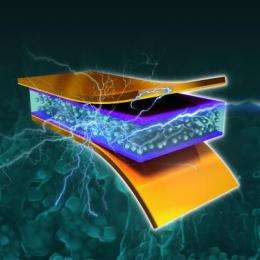Power generation technology based on piezoelectric nanocomposite materials

Professor Keon- Jae Lee's research team, KAIST (Korea), has developed a nanocomposite-based nanogenerator that successfully overcomes the critical restrictions existed in previous nanogenerators and builds a simple, low-cost, and large-scale self-powered energy system. The team produced a piezoelectric nanocomposite by mixing piezoelectric nanoparticles with carbon-based nanomaterials in a polydimethylsiloxane matrix and fabricated the nanocomposite generator by the simple process of spin-casting or bar-coating method.
The team of Professor Keon Jae Lee from the Department of Materials Science and Engineering, KAIST, has developed new forms of low cost, large-area nanogenerator technology using the piezoelectric ceramic nanoparticles.
Piezoelectric effects-based nanogenerator technology that converts existing sources of nonpolluting energies, such as vibrational and mechanical energy from the nature of wind and waves, into infinite electrical energy is drawing immense interest in the next-generation energy harvesting technology. However, previous nanogenerator technologies have limitations such as complicated process, high-cost, and size-related restrictions.
Recently, Professor Lee's research team has developed a nanocomposite-based nanogenerator that successfully overcomes the critical restrictions existed in previous nanogenerators and builds a simple, low-cost, and large-scale self-powered energy system. The team produced a piezoelectric nanocomposite by mixing piezoelectric nanoparticles with carbon-based nanomaterials (carbon nanotubes and reduced graphene oxide) in a polydimethylsiloxane (PDMS) matrix and fabricated the nanocomposite generator by the simple process of spin-casting or bar-coating method.
Professor Zhong Lin Wang from Georgia Institute of Technology, who is the inventor of the nanogenerator, said: "This exciting result first introduces a nanocomposite material into the self-powered energy system, and therefore it can expand the feasibility of nanogenerator in consumer electronics, ubiquitous sensor networks, and wearable clothes."
More information: The research result was published in the May online issue of the Advanced Materials journal as a cover paper.
Journal information: Advanced Materials

















